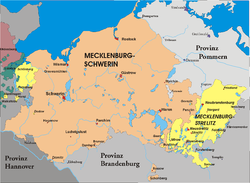Second partition of Mecklenburg
The second partition of Mecklenburg took place in 1621 as a result of the Fahrenholzer Vertrag: a partition agreement, resulting in the Realteilung into the Duchy of Mecklenburg-Schwerin and Mecklenburg-Güstrow. Although this division already existed (with interruptions) after the death of Henry IV in 1477 and again after 1520 (after the Neubrandenburger Hausvertrag (New Brandenburg House Contract)), it was only in the form of an allocation of Ämter (singular Amt; a type of administrative division), while general governance remained unified.
In the agreement, Adolf Frederick I received the princely state of Schwerin, while his brother John Albert II received the land centred on Güstrow. [2] : 182
The divisions had little historical basis. The most important goals were to divide the amount of territory and income as evenly as possible. In order to achieve this, Schwerin received the previously Güstrow-aligned Ämter of Grabow, Gorlosen, Marnitz, Neukloster and Sternberg including the Abbey of Walsmühlen while Güstrow received the Ämter of Strelitz, Goldberg, Wredenhagen and Fürstenberg from Schwerin. [2] : 290
Therefore, the two portions consisted of the following Ämter: [2] : 290
- Schwerin: Schwerin, Crivitz, Neubukow, Poel, Doberan, Mecklenburg, Gadebusch, Zarrentin, Neustadt Eldena, Dömitz, Neukloster, Sternberg, Lübz, Rehna, Wittenburg, Marnitz, Grabow, Grevesmühlen, Walsmühlen and Gorlosen
- Güstrow: Güstrow, Schwaan, Ribnitz, Gnoien, Dargun, Neukalen, Stavenhagen, Plan, Stargard, Broda, Feldberg, Wesenberg, Strelitz, Goldberg, Boizenburg, Wredenhagen, Fürstenberg, Ivenack and Wanzka
Note however that the Ämter of Wredenhagen, Fürstenberg, Ivenack and Wanzka were de facto controlled by Pomerania. [2] : 290
The cities were divided such that Schwerin received: Wismar, along with all the princely houses, Schwerin, Parchim, Waren and Kröpelin; the noble towns of Brüel, Malchow and Dassow, as well as Dömitz and Zarrentin. Güstrow received: Güstrow, Laage, Krakow, Malchin, Robel, Teterow, Neubrandenburg, Friedland, Woldegk, Penzlin, Sülze and Marlow. It also gained the Elbe (despite its remoteness from Güstrow) as a result of gaining the Amt of Boizenburg. [2] : 290
The town of Rostock including Warnemünde remained a joint possession, as did the state's four Abbeys: Dobbertin, Malchow, Ribnitz and the Abbey of the Holy Cross in Rostock. The courts (Hofgericht and Landgericht), the Papal consistory, the State Diet, border disputes, the cost of the Reichskammergericht etc. also remained joint concerns. [2] : 291
This page is based on this
Wikipedia article Text is available under the
CC BY-SA 4.0 license; additional terms may apply.
Images, videos and audio are available under their respective licenses.


